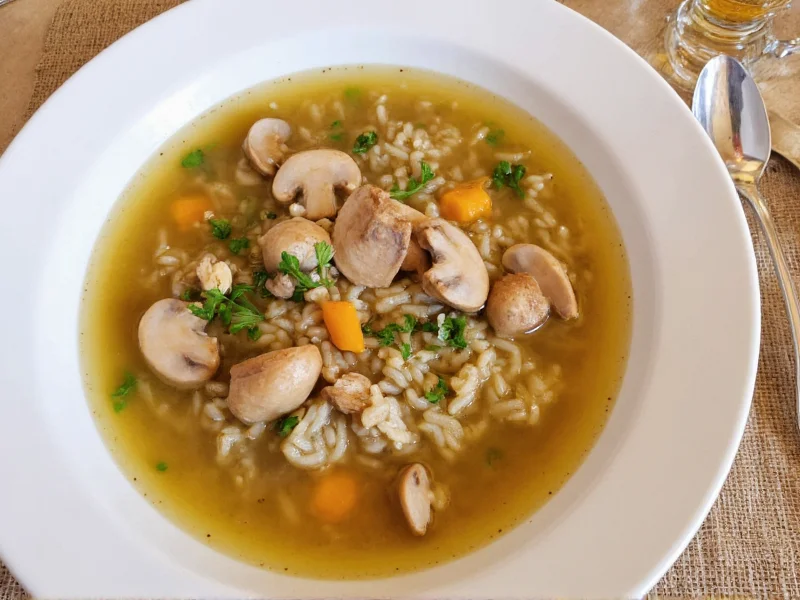Creating the perfect chicken rice mushroom soup requires attention to ingredient quality and cooking technique. This beloved comfort food combines the savory richness of chicken with the earthy depth of mushrooms and the satisfying texture of rice. Whether you're seeking a quick weeknight dinner or a healing remedy for cold days, this versatile soup adapts beautifully to various cooking methods and dietary preferences.
Essential Ingredients for Superior Flavor
The foundation of exceptional chicken rice mushroom soup lies in selecting quality ingredients. Bone-in chicken pieces—preferably thighs or a whole chicken cut up—provide superior flavor compared to boneless options. The bones release collagen during cooking, creating a naturally rich, slightly gelatinous broth that's both nutritious and satisfying.
Fresh mushrooms make a significant difference in flavor depth. Cremini mushrooms offer an ideal balance of earthiness and mild flavor, while shiitakes provide a more robust umami punch. For the best results, slice mushrooms uniformly to ensure even cooking. Long-grain white rice like basmati or jasmine maintains its shape better than short-grain varieties, though converted rice works well for longer storage.
| Ingredient | Quantity | Preparation Notes |
|---|---|---|
| Chicken pieces (bone-in) | 1.5 lbs (680g) | Brown skin-side down first for maximum flavor |
| Fresh mushrooms | 8 oz (225g) | Sauté separately before adding to soup |
| Long-grain rice | 1/2 cup (90g) | Rinse before adding to prevent cloudiness |
| Aromatic vegetables | 1 cup diced | Onion, carrot, celery in 2:1:1 ratio |
| Homemade broth | 6 cups (1.4L) | Simmer bones for 2+ hours for best results |
Step-by-Step Preparation Guide
Begin by preparing your broth base. If using raw chicken, brown the pieces skin-side down in a large pot until golden, then remove and set aside. Sauté diced onions, carrots, and celery until softened—this mirepoix forms the flavor foundation. Return chicken to the pot with enough water to cover by two inches, along with herbs like thyme and bay leaves.
Simmer gently for 45-60 minutes until chicken is cooked through. Remove chicken, strain the broth, then return the clear broth to the pot. While the broth simmers, sauté sliced mushrooms in butter until golden brown—this critical step enhances their flavor dramatically. Shred the cooled chicken, discarding skin and bones.
Add rinsed rice to the simmering broth and cook until nearly tender (about 15 minutes for white rice). Stir in the sautéed mushrooms and shredded chicken during the last 5 minutes of cooking. Season with salt, freshly ground black pepper, and a splash of lemon juice to brighten the flavors. For a richer version, stir in a tablespoon of heavy cream or coconut milk at the end.
Avoiding Common Preparation Mistakes
Many home cooks make the mistake of adding rice too early, resulting in mushy grains that break down completely. To prevent this, add rice when the soup has about 20 minutes left in cooking time. Another frequent error involves boiling mushrooms with the soup instead of sautéing them first—this causes them to absorb water rather than release their flavorful compounds.
Using pre-cooked chicken often yields less flavorful results than simmering raw chicken in the broth. The slow extraction of flavors from bones and connective tissue creates a more complex, satisfying base. If short on time, consider using high-quality store-bought broth but enhance it with additional chicken bones simmered for 30 minutes.
Variations for Different Dietary Needs
This versatile recipe adapts beautifully to various dietary requirements. For a gluten-free version, ensure your broth is certified gluten-free and avoid any flour-based thickeners. Those following a low-carb diet can substitute cauliflower rice, adding it during the final 5 minutes of cooking to maintain texture.
Vegan and vegetarian adaptations work well by replacing chicken with additional mushrooms and vegetable broth, though the resulting soup will lack the characteristic richness of the traditional version. For an extra-nutritious boost, stir in a handful of fresh spinach or kale during the last few minutes of cooking.
Storage and Reheating Best Practices
Proper storage ensures your chicken rice mushroom soup maintains quality. Cool the soup completely before transferring to airtight containers. When stored properly, it keeps for 3-4 days in the refrigerator or up to 3 months in the freezer. Rice tends to absorb liquid as it sits, so you'll likely need to add additional broth or water when reheating.
Reheat gently over medium-low heat, stirring occasionally to prevent sticking. Avoid boiling vigorously, which can cause the chicken to become tough. For frozen soup, thaw overnight in the refrigerator before reheating. The soup often tastes even better the second day as flavors continue to meld.
Nutritional Benefits of Chicken Rice Mushroom Soup
This comforting dish offers impressive nutritional value. A typical serving provides approximately 250-300 calories, with 20-25 grams of protein from the chicken. Mushrooms contribute selenium, B vitamins, and compounds that support immune function. The vegetables add fiber, vitamins A and C, while the broth provides hydration and electrolytes—making this soup particularly beneficial when recovering from illness.











 浙公网安备
33010002000092号
浙公网安备
33010002000092号 浙B2-20120091-4
浙B2-20120091-4